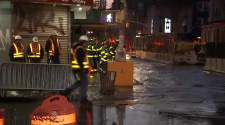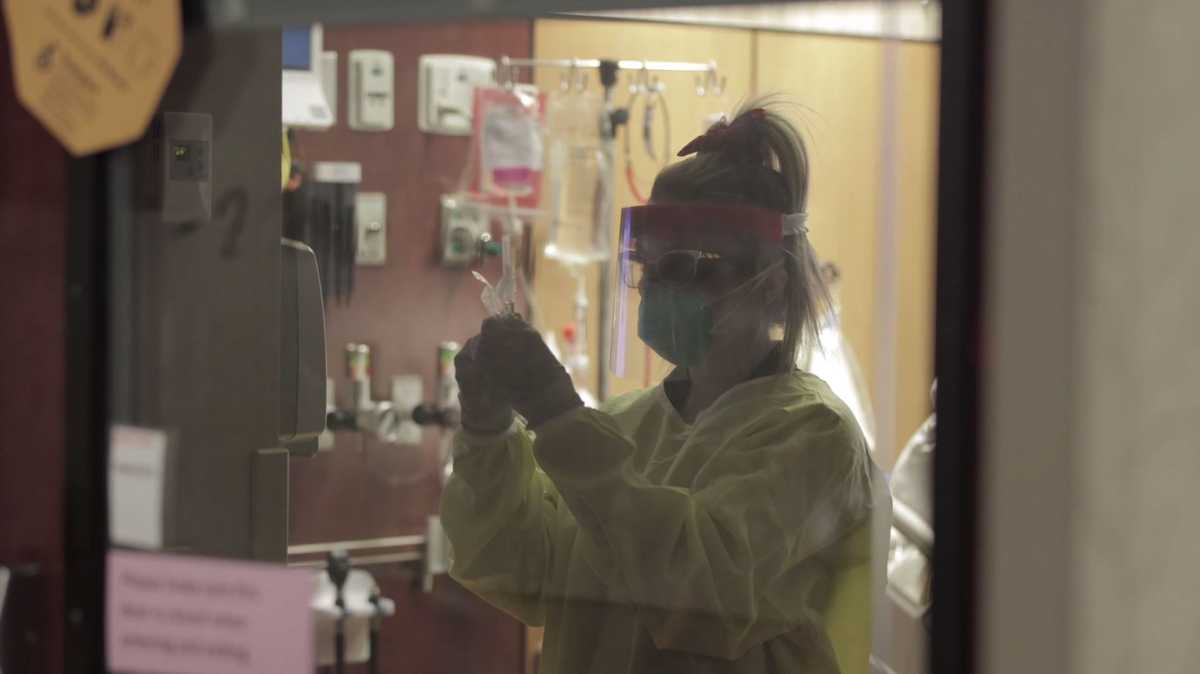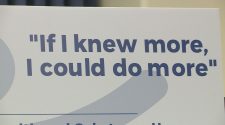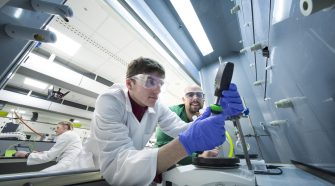The U.S. topped 20 million total infections and inched closer to 350,000 COVID-19 deaths on the first day of 2021 — reminders of a grim reality continuing into the new year.More people have died across the U.S. than anywhere else: nearly 348,000 Americans since the pandemic’s start. That’s while hospitalizations are at the highest levels they’ve ever been. The U.S. reported a record 125,379 hospitalized COVID-19 patients nationwide Thursday, according to the Covid Tracking Project. That number dipped slightly Friday, with 125,057 hospitalizations reported — about a 163% increase from two months ago.A California doctor said hospitals have hit a “breaking point.””We’re also worried that at some point soon we’re going to have a really tough time finding the space and the staff to take care of all the sick patients coming in with COVID-19 who really need our help,” said Dr. Nicole Van Groningen of Cedars-Sinai Medical Center in Los Angeles.And Friday’s bleak case milestone also means the nation has also recorded by far the most COVID-19 infections. It’s double what India — the country with the second-highest number of cases — has reported and nearly triple what Brazil — the third country in line — has reported.But the worst may not be over just yet: experts fear that in the coming weeks — following holiday travel and gatherings — the U.S. could see another surge of cases that could also drive hospitalizations and deaths even higher.Dr. Anthony Fauci told CNN earlier this week the country has seen a surge that has “just gotten… out of control,” and that the coming weeks could be even worse.”Once you get to large numbers of people at a dinner inside, poor air ventilation and circulation, that’s when you get in trouble,” he said. “That’s what we’re concerned about– that in addition to the surge, we’re going to have an increase superimposed upon that surge which could make January even worse than December.””I think we just have to assume that it’s going to get worse,” Fauci added.How states are faring at the start of a new yearIn Arkansas, Gov. Asa Hutchinson said Friday the state reported more than 4,300 new cases — a record high he said comes “in the surge after Christmas travel and gatherings.””As we enter this new year, our first resolution should be to follow guidelines. We all must do our part,” he wrote on Twitter.Georgia announced Friday a total of more than 8,700 new COVID-19 cases in the state — a new high. Maryland on the same day reported its second-highest number of daily cases. New York, meanwhile, added nearly 16,500 new cases — a day after it hit its highest ever one-day case count.”As we start 2021, I encourage all New Yorkers to look to their better angels and continue the practices we know stop the spread of this virus – wash your hands, socially distance, and wear a mask,” Gov. Andrew Cuomo said in a statement.Texas health officials reported record-high COVID-19 hospitalizations across the state for the fifth day in a row, with more than 12,400 patients.In California, a state that’s battled a brutal surge of new infections, hospitalizations and deaths, health officials reported a record daily death toll: more than 580 people lost to the virus.ICU capacity in many parts of the state remains dangerously low. In Southern California and the San Joaquin Valley, zero beds are available. One health official said earlier this week the surge of patients has been pushing hospitals to the “brink of catastrophe.”And that’s as some hospitals are having infrastructure issues that are preventing them from providing a high-pressure supply of oxygen to patients.The California Governor’s Office of Emergency Services said design and construction experts from the U.S. Army Corps of Engineers are being deployed to the Los Angeles region to “evaluate and where necessary upgrade oxygen delivery systems at six hospitals.”Hospitals in the region, the office said, are treating an “unprecedented” number of COVID-19 patients and “the internal oxygen delivery systems built into many older hospitals are being overtaxed by the volume of oxygen flow required to treat patients with respiratory issues that arise from COVID-19.”Testing company says virus variant not widespread in USAs officials nationwide battle the spread of the virus, they’re also monitoring for a variant that was first detected in the U.K. and could be more transmissible. The variant has been found in at least 30 countries and has also been detected in Colorado, California and Florida.Health officials in California first said Wednesday a 30-year-old San Diego man tested positive for the U.K. variant. On Thursday, county health officials told CNN three new cases of the variant were reported in San Diego.”The discovery of the additional cases leads county health officials to believe that the new strain of the virus is widespread in the community,” a county spokesperson said.The new cases were found in two men in their 40s and a man in his 50s, officials said.”Contact tracing shows two men did not travel outside of the county while the third case has yet to be fully interviewed,” officials said. “None of the men had any known interaction with each other or the other confirmed case.”But while some experts have said it’s likely the variant is circulating in the U.S., testing so far does not indicate it’s common across the country, genomics company Helix told CNN.Only four of 31 samples have turned up positive for the pattern of mutations first identified in the U.K., Helix said. The genetic pattern was first caught by a testing glitch that technicians call S gene dropout.”We also know that other labs in the Northeast sequencing S gene dropout samples have not found the UK variant in their populations,” Dr. James Lu, co-founder and president of Helix, told CNN by email.”We cannot say with confidence when the B.1.1.7 strain emerged in the U.S.,” Lu said. But it’s not common, which indicates it has not been circulating long.But the U.S. isn’t looking hard, Lu added.”Currently, the U.S. is doing less sequencing than many other countries — a recent report from (genomics database) GISAID estimated that the U.S. is sequencing 0.3% of positive cases versus the U.K. that’s at about 7%.”Fauci: US will continue giving vaccine doses weeks apartMeanwhile, COVID-19 vaccinations are ongoing, but at a pace slower than some officials hoped.More than 12.4 million vaccine doses have been distributed nationwide and more than 2.7 million doses have been administered, according to data from the U.S. Centers for Disease Control and Prevention.So far, the vaccines approved in the U.S. require two doses based a few weeks apart. And the nation will continue to do it that way and will not follow the U.K.’s decision to potentially delay second doses, Fauci told CNN on Friday.”I would not be in favor of that,” Fauci said when asked about the U.K.’s new dosing regimen. “We’re going to keep doing what we’re doing.”Earlier this week, British officials said the “U.K. will prioritize giving the first dose of the vaccine to those in the most high-risk group” and allow the second dose to be given up to 12 weeks later.The U.K. adopted that strategy in order to give as many people as possible the first dose as quickly as possible, saying that it affords some amount of protection.”The fact is we want to stick with what the science tells us, and the data that we have for both indicate you give a prime, followed by a boost in 21 days with Pfizer and 28 days with Moderna. And right now, that’s the way we’re going with it, and that’s the decision that is made,” Fauci said.”We make decisions based on data. We don’t have any data of giving a single dose and waiting for more than the normal period of time” to give the second dose, he added.
The U.S. topped 20 million total infections and inched closer to 350,000 COVID-19 deaths on the first day of 2021 — reminders of a grim reality continuing into the new year.
More people have died across the U.S. than anywhere else: nearly 348,000 Americans since the pandemic’s start.
That’s while hospitalizations are at the highest levels they’ve ever been. The U.S. reported a record 125,379 hospitalized COVID-19 patients nationwide Thursday, according to the Covid Tracking Project. That number dipped slightly Friday, with 125,057 hospitalizations reported — about a 163% increase from two months ago.
A California doctor said hospitals have hit a “breaking point.”
“We’re also worried that at some point soon we’re going to have a really tough time finding the space and the staff to take care of all the sick patients coming in with COVID-19 who really need our help,” said Dr. Nicole Van Groningen of Cedars-Sinai Medical Center in Los Angeles.
And Friday’s bleak case milestone also means the nation has also recorded by far the most COVID-19 infections. It’s double what India — the country with the second-highest number of cases — has reported and nearly triple what Brazil — the third country in line — has reported.
But the worst may not be over just yet: experts fear that in the coming weeks — following holiday travel and gatherings — the U.S. could see another surge of cases that could also drive hospitalizations and deaths even higher.
Dr. Anthony Fauci told CNN earlier this week the country has seen a surge that has “just gotten… out of control,” and that the coming weeks could be even worse.
“Once you get to large numbers of people at a dinner inside, poor air ventilation and circulation, that’s when you get in trouble,” he said. “That’s what we’re concerned about– that in addition to the surge, we’re going to have an increase superimposed upon that surge which could make January even worse than December.”
“I think we just have to assume that it’s going to get worse,” Fauci added.
How states are faring at the start of a new year
In Arkansas, Gov. Asa Hutchinson said Friday the state reported more than 4,300 new cases — a record high he said comes “in the surge after Christmas travel and gatherings.”
“As we enter this new year, our first resolution should be to follow guidelines. We all must do our part,” he wrote on Twitter.
Georgia announced Friday a total of more than 8,700 new COVID-19 cases in the state — a new high. Maryland on the same day reported its second-highest number of daily cases. New York, meanwhile, added nearly 16,500 new cases — a day after it hit its highest ever one-day case count.
“As we start 2021, I encourage all New Yorkers to look to their better angels and continue the practices we know stop the spread of this virus – wash your hands, socially distance, and wear a mask,” Gov. Andrew Cuomo said in a statement.
Texas health officials reported record-high COVID-19 hospitalizations across the state for the fifth day in a row, with more than 12,400 patients.
In California, a state that’s battled a brutal surge of new infections, hospitalizations and deaths, health officials reported a record daily death toll: more than 580 people lost to the virus.
ICU capacity in many parts of the state remains dangerously low. In Southern California and the San Joaquin Valley, zero beds are available. One health official said earlier this week the surge of patients has been pushing hospitals to the “brink of catastrophe.”
And that’s as some hospitals are having infrastructure issues that are preventing them from providing a high-pressure supply of oxygen to patients.
The California Governor’s Office of Emergency Services said design and construction experts from the U.S. Army Corps of Engineers are being deployed to the Los Angeles region to “evaluate and where necessary upgrade oxygen delivery systems at six hospitals.”
Hospitals in the region, the office said, are treating an “unprecedented” number of COVID-19 patients and “the internal oxygen delivery systems built into many older hospitals are being overtaxed by the volume of oxygen flow required to treat patients with respiratory issues that arise from COVID-19.”
Testing company says virus variant not widespread in US
As officials nationwide battle the spread of the virus, they’re also monitoring for a variant that was first detected in the U.K. and could be more transmissible. The variant has been found in at least 30 countries and has also been detected in Colorado, California and Florida.
Health officials in California first said Wednesday a 30-year-old San Diego man tested positive for the U.K. variant. On Thursday, county health officials told CNN three new cases of the variant were reported in San Diego.
“The discovery of the additional cases leads county health officials to believe that the new strain of the virus is widespread in the community,” a county spokesperson said.
The new cases were found in two men in their 40s and a man in his 50s, officials said.
“Contact tracing shows two men did not travel outside of the county while the third case has yet to be fully interviewed,” officials said. “None of the men had any known interaction with each other or the other confirmed case.”
But while some experts have said it’s likely the variant is circulating in the U.S., testing so far does not indicate it’s common across the country, genomics company Helix told CNN.
Only four of 31 samples have turned up positive for the pattern of mutations first identified in the U.K., Helix said. The genetic pattern was first caught by a testing glitch that technicians call S gene dropout.
“We also know that other labs in the Northeast sequencing S gene dropout samples have not found the UK variant in their populations,” Dr. James Lu, co-founder and president of Helix, told CNN by email.
“We cannot say with confidence when the B.1.1.7 strain emerged in the U.S.,” Lu said. But it’s not common, which indicates it has not been circulating long.
But the U.S. isn’t looking hard, Lu added.
“Currently, the U.S. is doing less sequencing than many other countries — a recent report from (genomics database) GISAID estimated that the U.S. is sequencing 0.3% of positive cases versus the U.K. that’s at about 7%.”
Fauci: US will continue giving vaccine doses weeks apart
Meanwhile, COVID-19 vaccinations are ongoing, but at a pace slower than some officials hoped.
More than 12.4 million vaccine doses have been distributed nationwide and more than 2.7 million doses have been administered, according to data from the U.S. Centers for Disease Control and Prevention.
So far, the vaccines approved in the U.S. require two doses based a few weeks apart. And the nation will continue to do it that way and will not follow the U.K.’s decision to potentially delay second doses, Fauci told CNN on Friday.
“I would not be in favor of that,” Fauci said when asked about the U.K.’s new dosing regimen. “We’re going to keep doing what we’re doing.”
Earlier this week, British officials said the “U.K. will prioritize giving the first dose of the vaccine to those in the most high-risk group” and allow the second dose to be given up to 12 weeks later.
The U.K. adopted that strategy in order to give as many people as possible the first dose as quickly as possible, saying that it affords some amount of protection.
“The fact is we want to stick with what the science tells us, and the data that we have for both [vaccines] indicate you give a prime, followed by a boost in 21 days with Pfizer and 28 days with Moderna. And right now, that’s the way we’re going with it, and that’s the decision that is made,” Fauci said.
“We make decisions based on data. We don’t have any data of giving a single dose and waiting for more than the normal period of time” to give the second dose, he added.

















